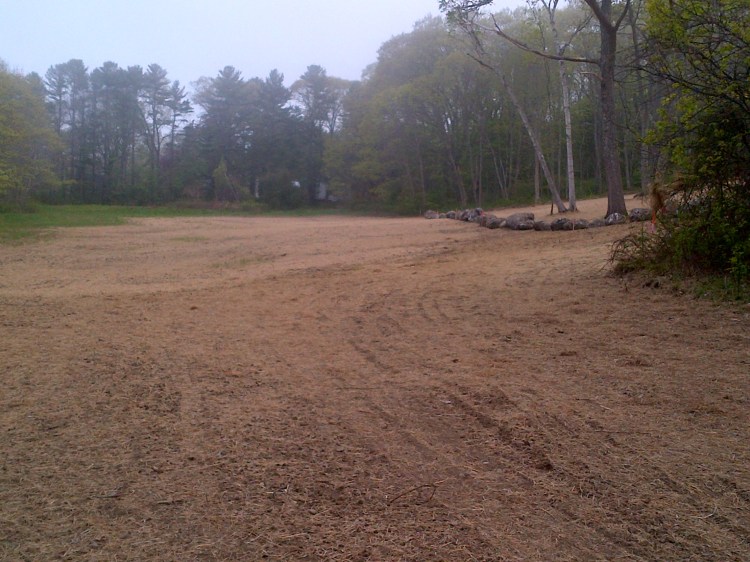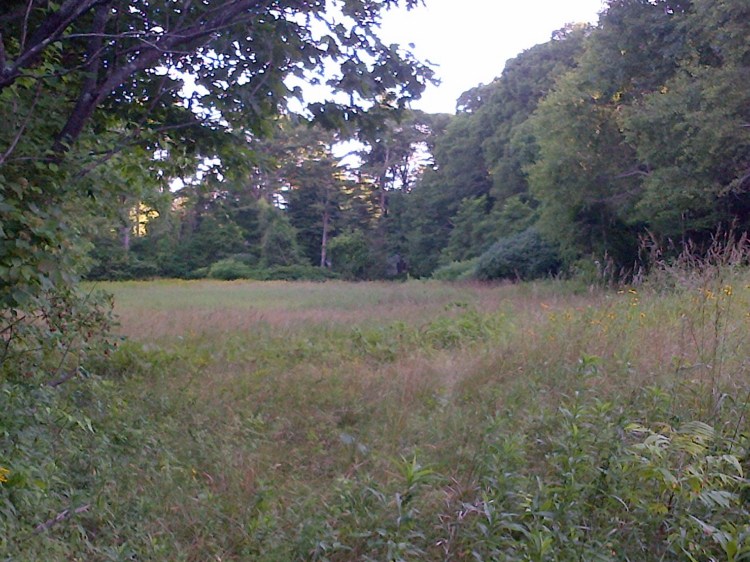A development company preparing to build homes on a previously undisturbed parcel of oceanfront land in Cumberland violated the terms of a conservation agreement in effect there when it destroyed about an acre of town-owned meadowland and scrub forest, using the area as a construction yard for tree-clearing.
The intrusion onto a town-owned portion of the former Payson property first raised eyebrows May 8, when town officials learned that contractors working for Bateman Partners of Portland at the site had used town land to store the cut timber, in the process destroying an acre of meadow, said William Shane, Cumberland’s town manager.
Shane said that where deep fescue grass and wildflowers once grew, felled trees lay in stacks, a tall mound of topsoil waited to be spread, and several pieces of other heavy equipment stood nearby.
“I met with the contractor on site, and basically I was kind of in shock,” Shane said. “There’s not a lot of meadow along the ocean, so this was kind of a neat place.”
Bateman’s contractors began clearing trees from the site in late April, working within the confines of the conservation rules and the layout of their development.
But at some point around May 7 or 8, the tree-cutting operation pushed into town-owned property, trespassing on the land and violating the terms of a conservation easement that controls the area.
Although the developer has vowed to correct the damage, replant trees and more closely follow standards at the site, the incident highlights the difficulty of developing a parcel of land that has drawn tremendous attention from residents, some of whom have stood opposed to the residential development in a formerly natural area, while others have objected to the town’s purchase of oceanfront land for use by the public.
Complicating matters further is the conservation easement, a dense, highly specific document that has controlled the site since 1997, when the former owner, Marion Payson, gave stewardship rights to a local land trust.
“If this was any other project this would be a non-issue,” said Nathan Bateman, the principal at Bateman Partners. “This was a highly controversial and highly scrutinized project.”
Controversy around the site began when Bateman Partners of Portland purchased 104 acres of the estate last year, before immediately selling about 25 acres to the town of Cumberland for beach access.
The Payson family, the property’s former owners, entered into a conservation easement in 1997, restricting uses at the site in perpetuity and giving stewardship rights to the Chebeague and Cumberland Land Trust.
Bateman was approved by the town and the Land Trust to build 10 homes on its wooded parcel.
In a referendum, Cumberland residents narrowly approved – by a vote of 2,372 to 2,126 – $3 million to buy the town’s portion of the land.
The town heralded the opportunity as a chance to provide residents for the first time with shoreland access, while the Payson family heirs, who have an interest in the property but no legal standing to decide its use, attempted to stop the town from using the land for public access.
But a lawsuit they filed was thrown out of court on May 5, clearing the town’s way forward. Planners are working on a design for a parking area to support the beach access.
The portion of land owned by the town that was damaged is among the nine acres located next to Route 88. The town also owns a half-mile right of way leading to about 14 acres of prime shoreland, with sandy beaches at low tide and a 220-foot pier.
The area was supposed to be part of a walking trail that loops around the property, which would have become the first new feature of the natural site that would be opened to the public since its sale in 2014.
But whether that trail will be ready for the public’s use before the end of summer remains unknown.
Bateman took full responsibility for the intrusion, and said his contractors would be better educated going forward about what is and isn’t allowed on the closely controlled site.
Penny Asherman, president of the land trust’s board, said her group was “dismayed” by the actions of the developer.
The Chebeague and Cumberland Land Trust “is continuing regular site visits to the property, documenting activity and working to prevent any additional violations,” Asherman said in a statement. “(The land trust) is committed to protection of this property as outlined in the terms (of) the conservation easement by all owners and users, now and in the future.”
Asherman did not respond to questions about how, in its stewardship of the land, the land trust allowed the violations to progress to the point they had.
Shane said that a revegetation plan is expected to be submitted to the town within the week that will detail further plantings, including 30 to 40 juvenile trees and more forms of native grass, flowers and shrubs.
Bateman and Shane both estimated it could be two or three years before the site is restored to its former state.
“It was definitely a mistake,” Bateman said. “When everything grows back, it will be better than when we started.”
Send questions/comments to the editors.





Success. Please wait for the page to reload. If the page does not reload within 5 seconds, please refresh the page.
Enter your email and password to access comments.
Hi, to comment on stories you must . This profile is in addition to your subscription and website login.
Already have a commenting profile? .
Invalid username/password.
Please check your email to confirm and complete your registration.
Only subscribers are eligible to post comments. Please subscribe or login first for digital access. Here’s why.
Use the form below to reset your password. When you've submitted your account email, we will send an email with a reset code.